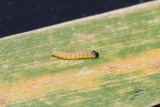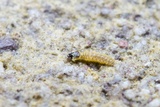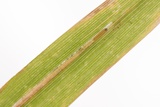Cosmopterix orichalcea Stainton, 1861 Species
Last modified: Dec. 2, 2024, 1:08 p.m.
First observation in Belgium in 2014 in LX. Hitherto a very rare and local species in our country, only known from a few localities.
Details
- Classification
- Family: Cosmopterigidae > Subfamily: Cosmopteriginae > Genus: Cosmopterix > Species: Cosmopterix orichalcea
- Vernacular names
- Grasprachtmot (NL), Rohrschwingel-Prachtfalter (DE)
- First mention in Belgium
- Molitor B. 2016. Cosmopterix orichalcea (Lepidoptera: Cosmopterigidae) espèce nouvelle pour la faune belge. — Phegea 44(2): 31–32. On page 31. view page
- Status
-
Native
Distribution
Mine
The mine starts as a straight gallery, the frass is concentrated at the beginning of the mine. Later on the mine broadens to an irregular blotch often occupying the entire leaf tip.
See also bladmineerders.be
Bionomics
Some larvae sometimes make more than one mine. When full-fed the larva leaves the mine and spins a tough white elongate cocoon on one of the leaves or amongst debris on the ground. The species hibernates in the larval stage.
Pupation in the cocoon after hibernation.
Adults can easily be swept from the food plants during the day.
Flight periods
One generation a year from the end of May till August.
Observed on
- Host plant (species):
- Phalaris arundinacea, Anthoxanthum odoratum, Festuca arundinacea and Phragmites australis
- Host plant (genera):
- Milium
- Substrates:
- Grasses
Oligophagous on grasses.
Habitat
Humid places, fens, damp woodland, ditches, banks of rivers.



